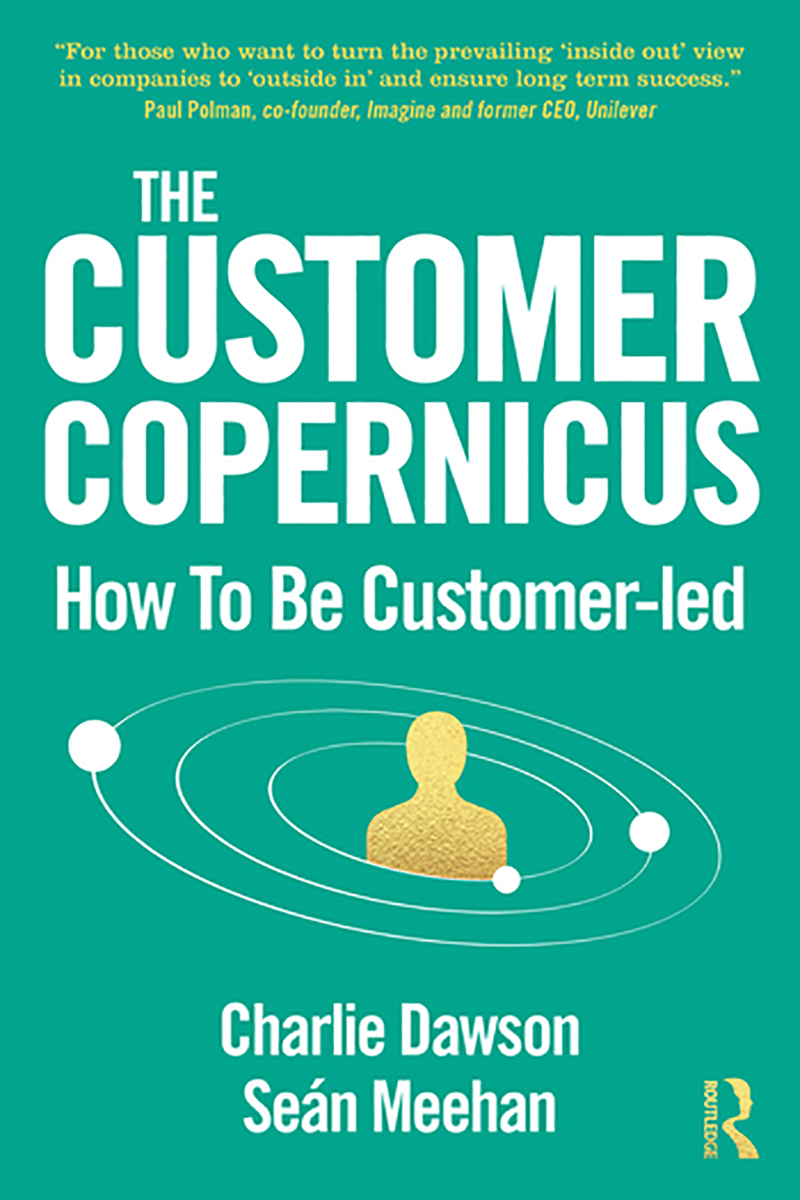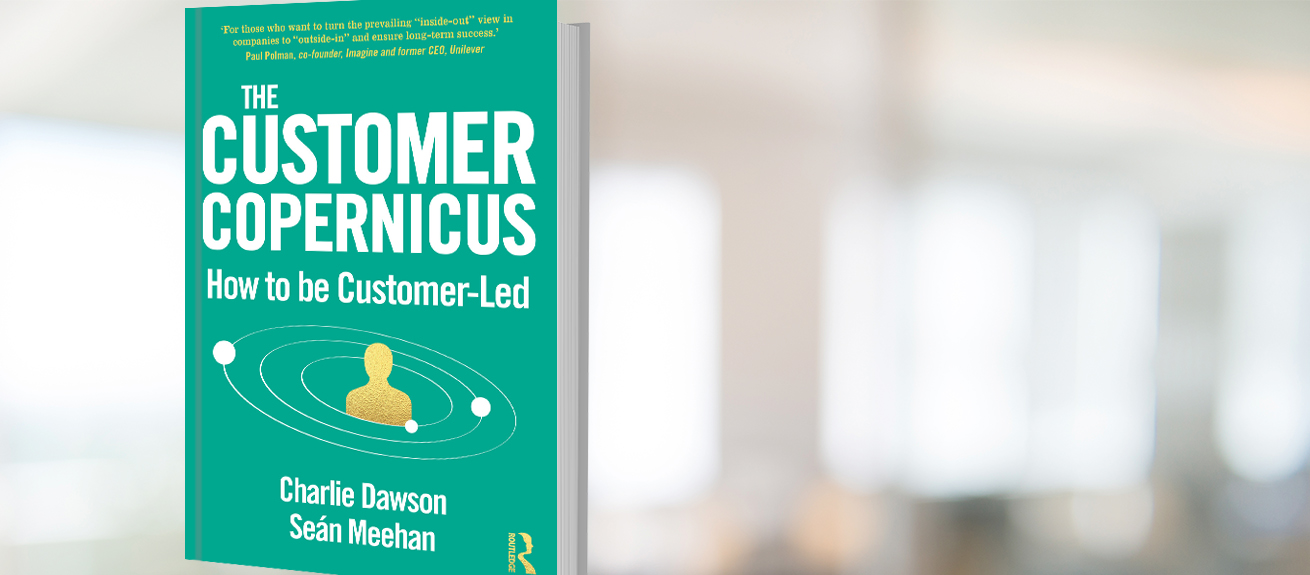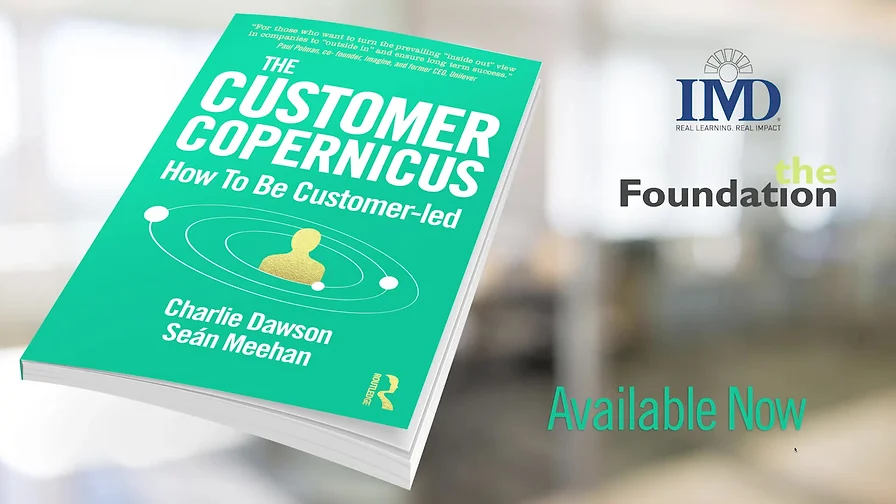Everyone talks about being customer-led, very few do it for real. The Customer Copernicus explains why, based on real-world examples. It has practical guidance on how to do better. If you’re saying you want to be a customer-led success, read this. It will help.
Business leaders often say “we are customer focused” and the words sound good. But how often are they true? Like the great astronomer Copernicus, The Customer Copernicus is a different way of looking at the world showing what “customer focus” really means. Fact-based, opinionated, challenging and ultimately inspiring, Dawson and Meehan explain how “outside-in” beliefs can transform an ailing business into a fnancial success and an innovator making life better for its customers. If you have time for only one business book this year, this would be the one.
Charlie Dawson and Seán Meehan explain very vividly what it takes to transform an organisation towards a customer centricity and how to avoid falling back into old habits. The different case studies are brilliant examples of how companies can achieve a sustainable shift towards an outside-in customer-led organisation and that all starts with a strong belief to do the right thing for its customers. Especially in today’s time, this book is a great reminder and a demonstration that organisations will only deliver superior business results in the long term if they put the customer needs at the centre of their marketing activities.
The most inspiring and impressive entrepreneurs and founders I know believe unconditionally in putting customers and the frontline frst. The Customer Copernicus is really refreshing and hugely important, especially today – it ought to be on the desk of every CEO!
Customer-centric systems and behaviours are the key to success. But if it’s that obvious why is it so hard to do … and harder yet to sustain? Dawson and Meehan take this puzzling conundrum and propose well thought out and actionable solutions. A must read for business leaders navigating today’s markets.
Outside-in thinking with the customer at the centre, sustained by many Moments of Belief, has been critical to DBS’ evolution. The Customer Copernicus will put you on this path.
CEOs never fail to say that the customer is the heart of their business
– and some might even believe it – but they seldom do what it takes to make it a reality. This book lifts the veil. It shows what customer focus actually means, how companies put it into practice, and how they keep it alive amid all the vicissitudes of business life. This book helps companies to survive.
The defnitive book on how to build, nurture, and sustain a customer-led organisation. Dawson and Meehan show how frms through shared beliefs, systems, processes, and engrained customer obsession make it “how things are always done around here.
At Tesco in thirty years we went from a 10% to a 30% market share. We did it by becoming more and more customer focused. Seán and Charlie have worked hard to fnd out how it was done by Tesco and many other businesses besides. Lots to learn here.
For those who want to turn the prevailing “inside-out” view in companies to “outside-in” and ensure long-term success.
Putting customers frst is simple to say but hard to do. Using real-world stories, The Customer Copernicus shows why and what it takes to succeed. These ideas would be useful to anyone looking to run a more successful, more sustainable business.
Customers are the lifeblood of any healthy business. The Customer Copernicus explains how and why they need to be at the centre of our thinking and why this is much more diffcult than it may seem.
The Customer Copernicus produces the answer to a pertinent question – if the customer at the centre of business thinking is such simple common sense, why do most organisations find it so diffcult?
Customers not CEOs determine a company’s success. Yet being customer-led remains elusive for many.
It’s why Tesco went from market trader to the third largest retailer in the world then had by a very public collapse, AO went from nothing to leadership of a hugely competitive sector and a £1 billion valuation in 15 years, and Sky made and won a series of make-or-break bets based on a belief that customers would pay for better TV.
Packed with compelling case studies and based on decades of research and practice, The Customer Copernicus by Charlie Dawson and Seán Meehan reveals how to transform an ordinary business into a customer-led success.
It explores how some companies are great for customers – like Amazon, EasyJet and Sky. They make things easier and improve what really matters – obvious, surely? They have also enjoyed huge business success.
But, if it’s obvious and attractive, why is it so rare? And why, having mastered it, would you ever stop? Tesco, O2 and Wells Fargo were like this once. Because all three stopped, and two ended up in court.
For more customer-led successful stories, read here
The tough but worthwhile journey from an ‘inside-out’ to an ‘outside-in’ belief system
The book explores why the shared beliefs of people in an organisation are central to this conundrum and how changing from an ‘inside-out’ to ‘outside-in’ belief system is crucial but also extremely hard. Most companies are self-interested. They start with what matters to their business and push it out into the world. An ‘outside-in’ mentality is unnatural – starting with the customer, understanding what they value, the problems they’re really trying to solve, and finding new and better ways of solving them, not just selling more. The book shows how to navigate this journey, escaping the dominant shareholder-first principle and growing belief in a customer-first approach. It shows why ultimately this is also better for business including shareholders, not just for customers.
‘Burningness’ then creating ‘Moments of Belief’
Dawson and Meehan argue the only way to create an ‘outside-in’ mentality is through bold, risky, costly, customer-led initiatives, hard to justify because they all look the same – the benefit to the customer is clear but in advance, the benefit to the business isn’t. The book reveals what conditions are needed to start taking these kinds of steps – a sense of being on fire – and then how beliefs in the business change when people see customer-led initiatives benefitting the business. These are called Moments of Belief and one leads to more, belief growing across the company that every time the business does something good for customers, it works for the business too. Eventually being customer-led becomes ‘the way we do things around here’.
How to become a pioneering customer-led business
Using real-world examples, the book guides readers though what it takes to become, AND to remain, a customer-led organisation, revealing:
- How being customer-led leads to market leadership and growth well beyond a sector
- Why establishing customer-led shared beliefs about what success is and how it’s achieved is critical, and how to go about it
- What the journey from conventional self-interest to extraordinary customer-led success looks like, stage by stage, with multiple examples
- The inevitability of, eventually, losing customer-led beliefs and how to protect them so they last for as long as possible
Research Information & Knowledge Hub for additional information on IMD publications
- The Customer Copernicus: How to be customer-led
- The key to putting customers at the center of your business
- The questions that reveal your company’s culture
- What lights a fire within your company?
- The Customer Copernicus: How to be customer-led
- The key to putting customers at the center of your business
- The questions that reveal your company’s culture
- What lights a fire within your company?

You can also buy the book on Barnes & Nobles, Book Depository, Orell Füssli and Routledge.
Research Information & Knowledge Hub for additional information on IMD publications
in I by IMD Brain Circuits 1 December 2021
Research Information & Knowledge Hub for additional information on IMD publications
Research Information & Knowledge Hub for additional information on IMD publications
Research Information & Knowledge Hub for additional information on IMD publications
Founded by Lim Hock Chee in 1985, Sheng Siong has evolved from a humble grocery store into a leading supermarket chain in Singapore, renowned for its cost-effective pricing and commitment to customer satisfaction. Mr Lim’s unique philosophy, which...

Customer retention is a long-term endeavor. By securely locking customers into a game, firms can generate more value from them and gain a crucial competitive edge.
Since becoming DBS Bank’s CEO in 2009, Piyush Gupta led its transformation to become a standard setter globally for digitalization and customer centricity in financial services. This transformation started with fixing the basics (2009-2014), in wh...
To stay ahead of competitors, DBS knew it needed to continue to innovate and improve customer centricity. To do so, it decided to move to a horizontal organizational structure, an approach it named Managing Through Journeys (MtJs). This involved b...

Wharton professor Peter Fader unpacks the transformative power of customer centricity and why understanding customer lifetime value is crucial for business success.
In this interview with Piyush Gupta CEO of DBS, we explore the bank’s market-oriented transformation journey from an underperforming mainly local Singaporean bank to becoming a globally significant Asian-based player earning accolades such as “Wor...

Chris Tung is President of Strategic Development at Chinese e-commerce multinational Alibaba Group. He tells Amit Joshi how the company is integrating AI to optimize its customer experience.

Businesses can retain customers, attract new ones or shape their preferences by aligning key game design elements with strategic objectives.

Chris Tung is President of Strategic Development at Alibaba Group, a Chinese multinational specializing in e-commerce, retail, and technology. He tells Amit Joshi how the company is integrating AI to optimize its customer experience.

Businesses can retain customers, attract new ones or shape their preferences by aligning key game design elements with strategic objectives, explains Konstantinos Trantopoulos.
Research Information & Knowledge Hub for additional information on IMD publications
in I by IMD Brain Circuits 18 December 2024
Research Information & Knowledge Hub for additional information on IMD publications
Case reference: IMD-7-2633 ©2024
Research Information & Knowledge Hub for additional information on IMD publications
To stay ahead of competitors, DBS knew it needed to continue to innovate and improve customer centricity. To do so, it decided to move to a horizontal organizational structure, an approach it named Managing Through Journeys (MtJs). This involved b...
Case reference: IMD-7-2634 ©2024
Research Information & Knowledge Hub for additional information on IMD publications
Since becoming DBS Bank’s CEO in 2009, Piyush Gupta led its transformation to become a standard setter globally for digitalization and customer centricity in financial services. This transformation started with fixing the basics (2009-2014), in wh...
in I by IMD 19 July 2024
Research Information & Knowledge Hub for additional information on IMD publications
in AMS Review June 2024, vol. 14, pp. 158–167, https://doi.org/10.1007/s13162-024-00278-6
Research Information & Knowledge Hub for additional information on IMD publications
Research Information & Knowledge Hub for additional information on IMD publications
in I by IMD 8 April 2024
Research Information & Knowledge Hub for additional information on IMD publications
Research Information & Knowledge Hub for additional information on IMD publications
in I by IMD Magazine March 2024, no. 13, pp. 44-47
Research Information & Knowledge Hub for additional information on IMD publications








